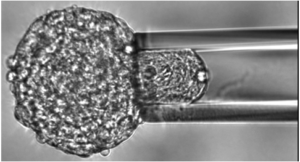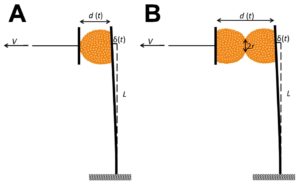 Aggregate shivering. During my postdoctoral stay at Institut Curie, working with Françoise Brochard-Wyart, I started studying the mechanical characterization of multicellular structures (such as a tissue or a tumor) in the presence of strong forces or flows. At Institut Curie we used spheroidal cellular aggregates as an in vitro model of a tissue. With Karine Guevorkian and others, we identified and described a collective contractile cell response to force, which we called aggregate shivering.
Aggregate shivering. During my postdoctoral stay at Institut Curie, working with Françoise Brochard-Wyart, I started studying the mechanical characterization of multicellular structures (such as a tissue or a tumor) in the presence of strong forces or flows. At Institut Curie we used spheroidal cellular aggregates as an in vitro model of a tissue. With Karine Guevorkian and others, we identified and described a collective contractile cell response to force, which we called aggregate shivering.
 Detachment and fracture of cellular aggregates. During the master’s internship of Louise Bonnemay, we developed an assay to measure the detachment energy of an aggregate from a fibronectin-coated substrate (to mimic integrin-mediated cell-matrix adhesion) and the fracture between two-partially fused aggregates (to mimic cadherin-mediated intercellular adhesion). We experimentally demonstrated a dependence of the adhesion energy on the velocity of force application. We also developed a theoretical model showing an analogy between the fracture of soft tissues and that of polymers.
Detachment and fracture of cellular aggregates. During the master’s internship of Louise Bonnemay, we developed an assay to measure the detachment energy of an aggregate from a fibronectin-coated substrate (to mimic integrin-mediated cell-matrix adhesion) and the fracture between two-partially fused aggregates (to mimic cadherin-mediated intercellular adhesion). We experimentally demonstrated a dependence of the adhesion energy on the velocity of force application. We also developed a theoretical model showing an analogy between the fracture of soft tissues and that of polymers.
 Interstitial flow through model tissues. In collaboration with the team of Marcos at Nanyang Technological University of Singapore we combine microfluidics and cellular aggregats in order to mimic interstitial flow through tumors. We have demonstrated that interstitial pressures corresponding to hypertension conditions induce aggregate fracture, which could translate to metastasis initiation. This topic has been studied by Duc-Quang Tran during his PhD thesis with us.
Interstitial flow through model tissues. In collaboration with the team of Marcos at Nanyang Technological University of Singapore we combine microfluidics and cellular aggregats in order to mimic interstitial flow through tumors. We have demonstrated that interstitial pressures corresponding to hypertension conditions induce aggregate fracture, which could translate to metastasis initiation. This topic has been studied by Duc-Quang Tran during his PhD thesis with us.